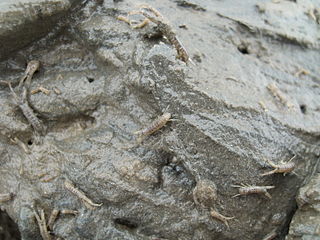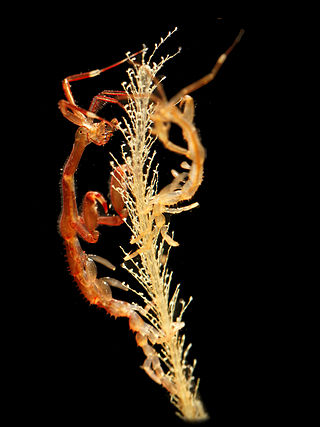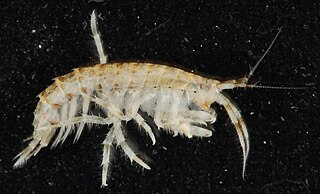
Zooplankton are the animal component of the planktonic community. Plankton are aquatic organisms that are unable to swim effectively against currents. Consequently, they drift or are carried along by currents in the ocean, or by currents in seas, lakes or rivers.

Amphipoda is an order of malacostracan crustaceans with no carapace and generally with laterally compressed bodies. Amphipods range in size from 1 to 340 millimetres and are mostly detritivores or scavengers. There are more than 9,900 amphipod species so far described. They are mostly marine animals, but are found in almost all aquatic environments. Some 1,900 species live in fresh water, and the order also includes the terrestrial sandhoppers such as Talitrus saltator and Arcitalitrus sylvaticus.

Leptostraca is an order of small, marine crustaceans. Its members, including the well-studied Nebalia, occur throughout the world's oceans and are usually considered to be filter-feeders. It is the only extant order in the subclass Phyllocarida. They are believed to represent the most primitive members of their class, the Malacostraca, and first appear in the fossil record during the Cambrian period.

Corophiidae is a family of amphipods, containing the following genera:
Chaetocorophium is a monotypic genus of amphipods in the family Corophiidae, containing only the species Chaetocorophium lucasi. Chaetocorophium is very closely related to Paracorophium, and some researchers propose synonymising the two genera.

Corophium is a genus of the amphipod family Corophiidae. Formerly a much larger genus, many species have been transferred to segregate genera such as Monocorophium and Crassicorophium.
Corophium arenarium is a small European amphipod crustacean of the family Corophiidae. It looks very similar to C. volutator.

Phronima sedentaria is a species of amphipod crustaceans found in oceans at a depth of up to 1 km (0.6 mi). They are large in size relative to other members of the family Phronimidae. Individuals may be found inside barrel-like homes, created most commonly from the tunics of select species of tunicate, where they rear their young. P. sedentaria is known to employ multiple feeding strategies and other interesting behaviors, including daily vertical migration. The species is also known by the more common names “pram bug” and “barrel shrimp.”

Hyalella azteca is a widespread and abundant species complex of amphipod crustacean in North America. It reaches 3–8 mm (0.12–0.31 in) long, and is found in a range of fresh and brackish waters. It feeds on algae and diatoms and is a major food of waterfowl.

Gammarus lacustris is an aquatic amphipod.

Parhyale hawaiensis is an amphipod crustacean species that is used in developmental and genetic analyses. It is categorized as an emerging model organism as the main biological techniques necessary for the study of an organism have been established.

Sinocorophium is a genus of amphipod crustaceans.
Maritrema subdolum is a species of parasitic fluke found in the Wadden Sea. It is related to the New Zealand species Maritrema novaezealandensis, and like its New Zealand relative, Maritrema subdolum infects local amphipods, in this case, Corophium volutator and Corophium arenarium. The cercariae of M. subdolum emerge from the first intermediate host, a gastropod of the genus Hydrobia for example, and seek out the next host, a crustacean. There the cercariae develop into metacercariae and form metacercarial cysts of different sizes.

Caprella mutica, commonly known as the Japanese skeleton shrimp, is a species of skeleton shrimp. They are relatively large caprellids, reaching a maximum length of 50 mm (2.0 in). They are sexually dimorphic, with the males usually being much larger than the females. They are characterized by their "hairy" first and second thoracic segments and the rows of spines on their bodies. Body color ranges from green to red to blue, depending on the environment. They are omnivorous highly adaptable opportunistic feeders. In turn, they provide a valuable food source for fish, crabs, and other larger predators. They are usually found in dense colonies attached to submerged man-made structures, floating seaweed, and other organisms.
Sunamphitoe femorata is a species of amphipod crustacean in the family Ampithoidae. It is a herbivore and constructs a tubular nest-like home on a blade of the sporophyte of the giant kelp Macrocystis pyrifera. This home is made by rolling the sides of the blade together and securing them with silk. As the kelp blade grows, the nest is advanced down the blade towards the base, approximately keeping pace with the algal growth.

Themisto is a genus of marine amphipods in the family Hyperiidae. Their distribution is cosmopolitan.

Gammarus mucronatus is a species of scud in the family Gammaridae. It is found in the coasts of the North American Atlantic seaboard and the Gulf of Mexico.
Pseudamphithoides incurvaria is a species of amphipod crustacean in the family Ampithoidae. It is native to shallow water in the tropical western Atlantic Ocean where it creates a home for itself from fragments of the algae on which it feeds. This seaweed contains certain chemicals that are distasteful and protect it from predatory fish.

Bathypolypus sponsalis, commonly called the globose octopus, is a deep sea cephalopod that can be found in both the eastern Atlantic Ocean and the Mediterranean Sea. It possesses many morphological traits adapted to a deep sea environment, including large eggs, reduced gills, no ink sac, and subgelatinous tissues. A distinguishing factor are the relatively large reproductive organs. Their diet consists of predominantly crustaceans and molluscs, but they sometimes consume fish as well. Bathypolypus sponsalis usually dies quickly after reproduction and only spawns once in their lifetime. Sexually mature females have a mantle length of at least 34 mm and sexually mature males have a mantle length of about 24 mm. Juveniles are white and transition to dark brown then to dark purple once maturity is reached.

Cystisoma is a genus of amphipod. It is the only member of the family Cystisomatidae within the Hyperiidea. The genus is noted for its nearly completely transparent body, adapted for life in low light waters.















